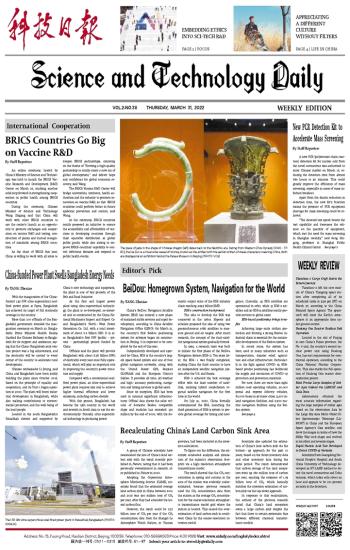
 Embedding Ethics into Sci-Tech R&D
Embedding Ethics into Sci-Tech R&D Appreciating a Different Culture Without Filters
Appreciating a Different Culture Without Filters New PCR Detection Kit to Accelerate Mass Screening
New PCR Detection Kit to Accelerate Mass Screening PHOTO NEWS
PHOTO NEWS BRICS Countries Go Big on Vaccine R&D
BRICS Countries Go Big on Vaccine R&D WEEKLY REVIEW
WEEKLY REVIEW China-funded Power Plant Swells Bangladesh Energy Needs
China-funded Power Plant Swells Bangladesh Energy Needs BeiDou: Homegrown System, Navigation for the World
BeiDou: Homegrown System, Navigation for the World Recalculating China's Land Carbon Sink Area
Recalculating China's Land Carbon Sink Area WECHAT ACCOUNT
WECHAT ACCOUNT E-PAPER
E-PAPER
A group of Chinese scientists have recalculated the size of China's land carbon sink with the result recently published in Nature, noting that it had been previously overestimated in research also published in Nature in 2020.
Adopting the Copernicus Atmosphere Monitoring Service (CAMS), scientists found that the estimated average land carbon sink in China between 2010 and 2016 was 920 million tons of CO_2 per year, after they had amended the lateral carbon flux.
However, the result could be 2.57 billion tons of CO_2 per year if the CO_2 concentration data from the Shangri-La Atmosphere Watch Station, in Yunnan province, had been included in the inversion calculation.
To figure out the difference, the scientists conducted analysis and simulation of the station's observation footprint via a high-resolution atmospheric transmittance model.
The result showed that the CO_2 concentration in spring and autumn in the area of the station was evidently underestimated, because previous research used the CO_2 concentration data from the station as the average CO_2 concentration for the coarse-resolution atmospheric transmittance model grid where the station is located. This caused the overestimation of land carbon sink in southwest China by the coarse-resolution inversion model.
Scientists also updated the estimation of China's land carbon sink via the bottom -up approach for the past 10 years, based on the forest inventory data and other inventory data during the same period. The result demonstrated that carbon storage of the land ecosystem went up 280 million tons of carbon per year, equaling the emission of 1.03 billion tons of CO_2, which basically matches the inversion estimation of carbon sink via the top-down approach.
In response to this recalculation, the authors of the previous research noted that China's land ecosystem owns a large carbon sink despite the fact that there is certain systematic bias between different chemical transmittance models.

 Next
Next



